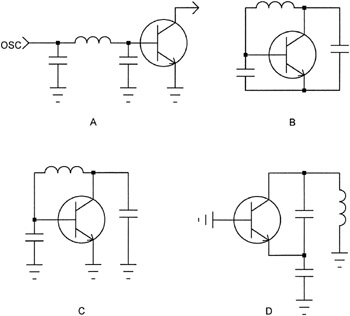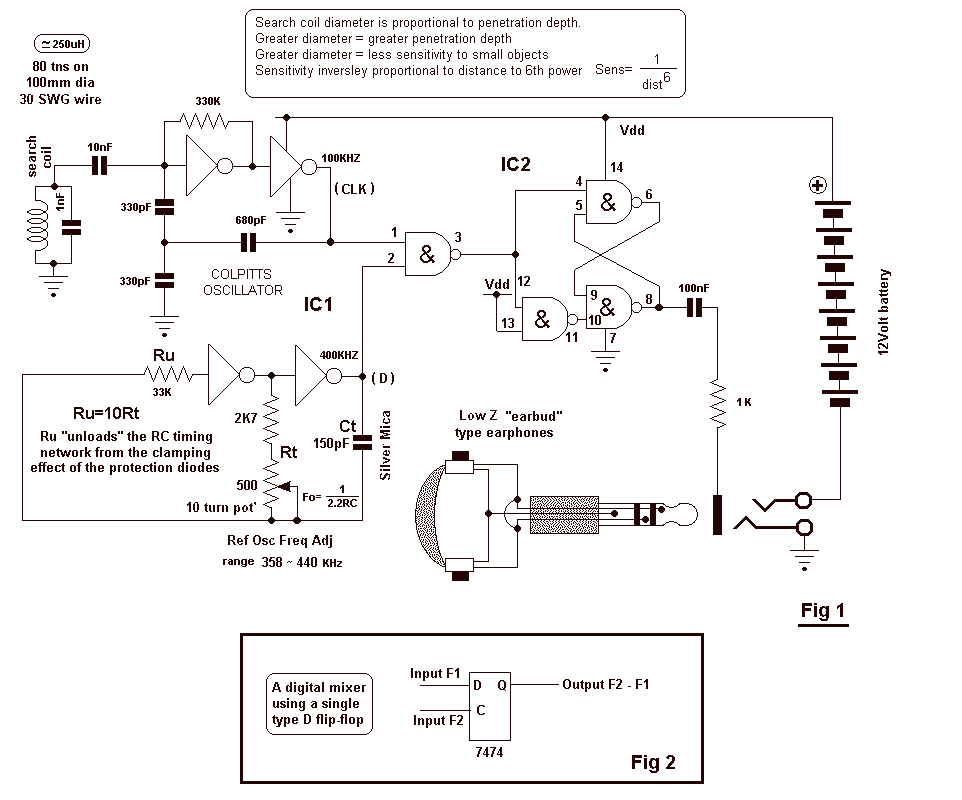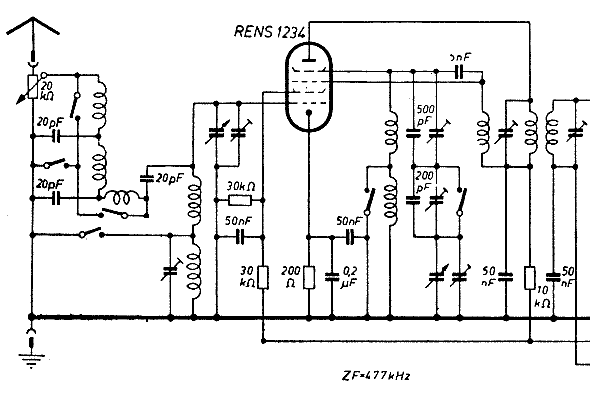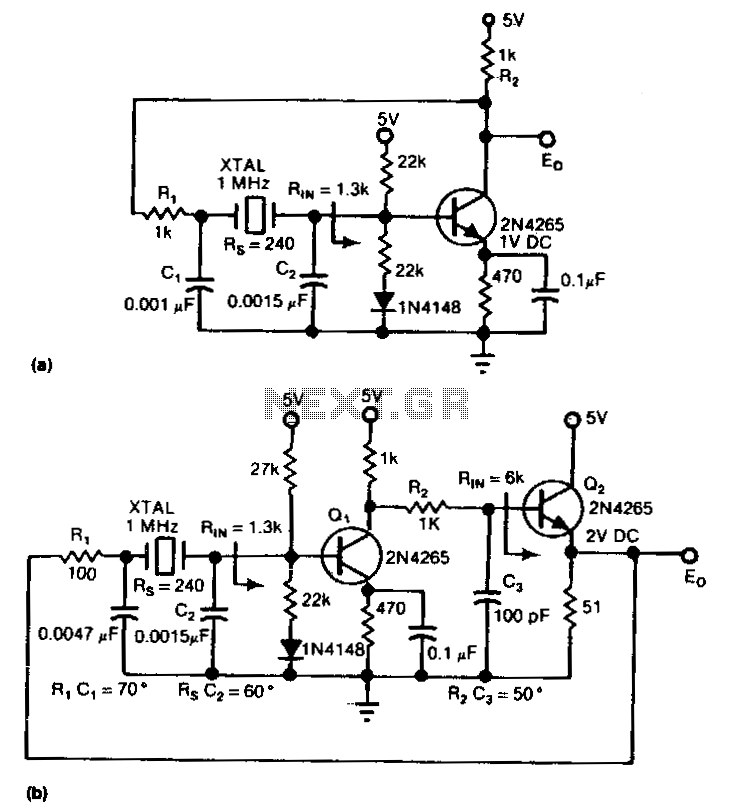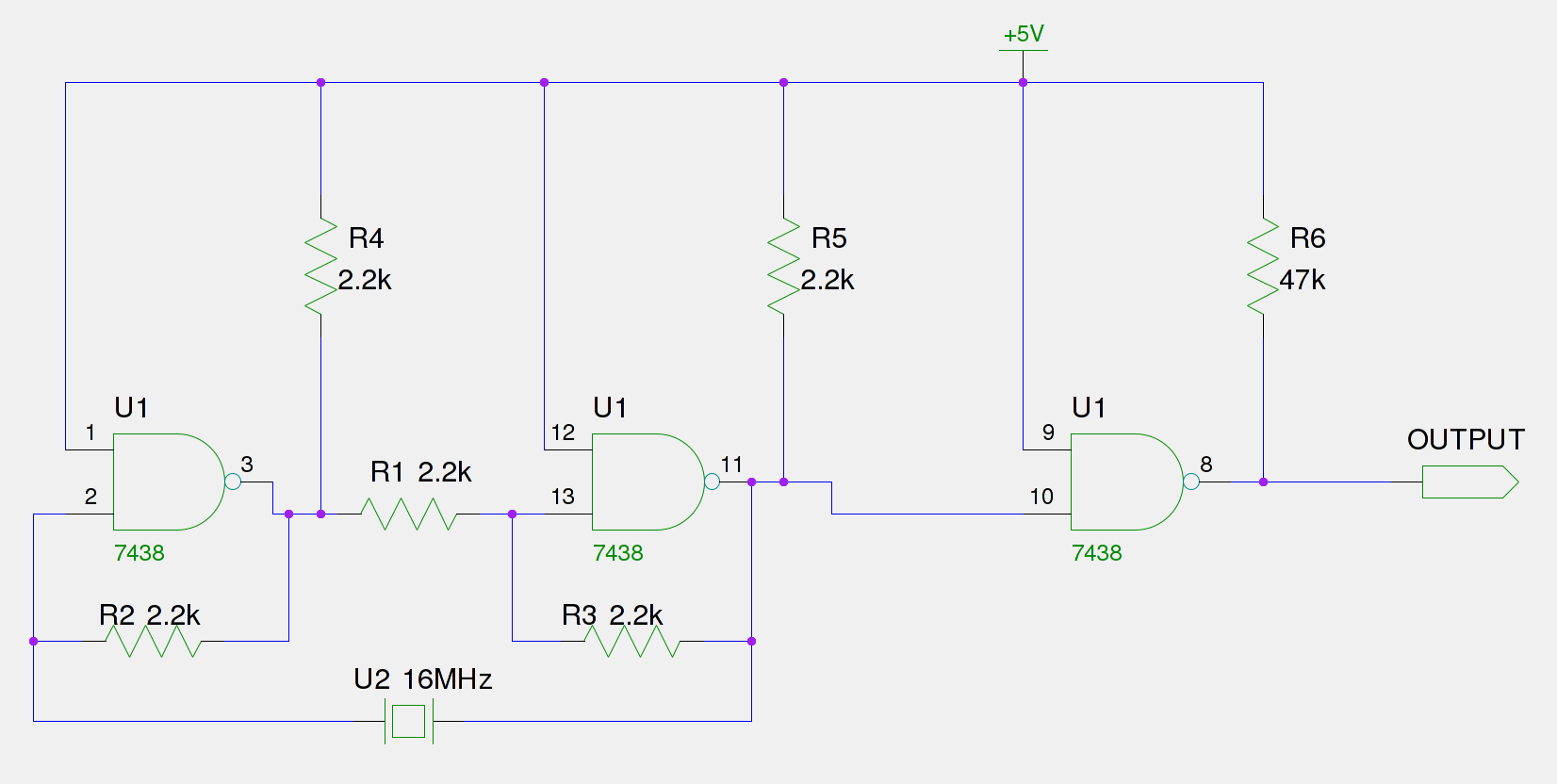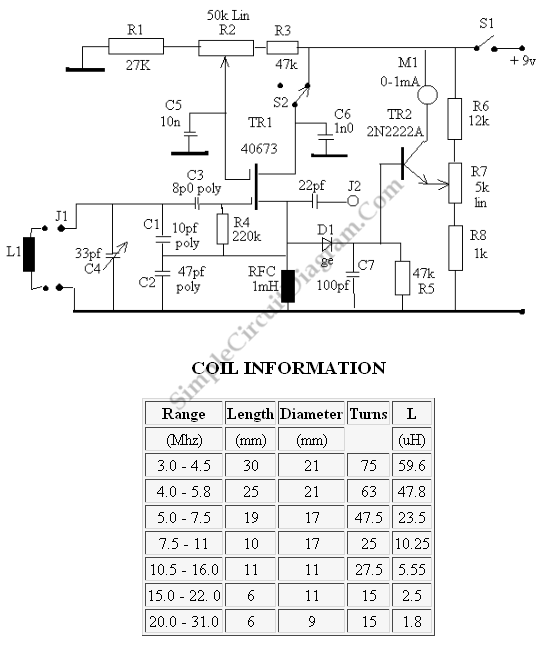
Quadrature Oscillator with TLV2474
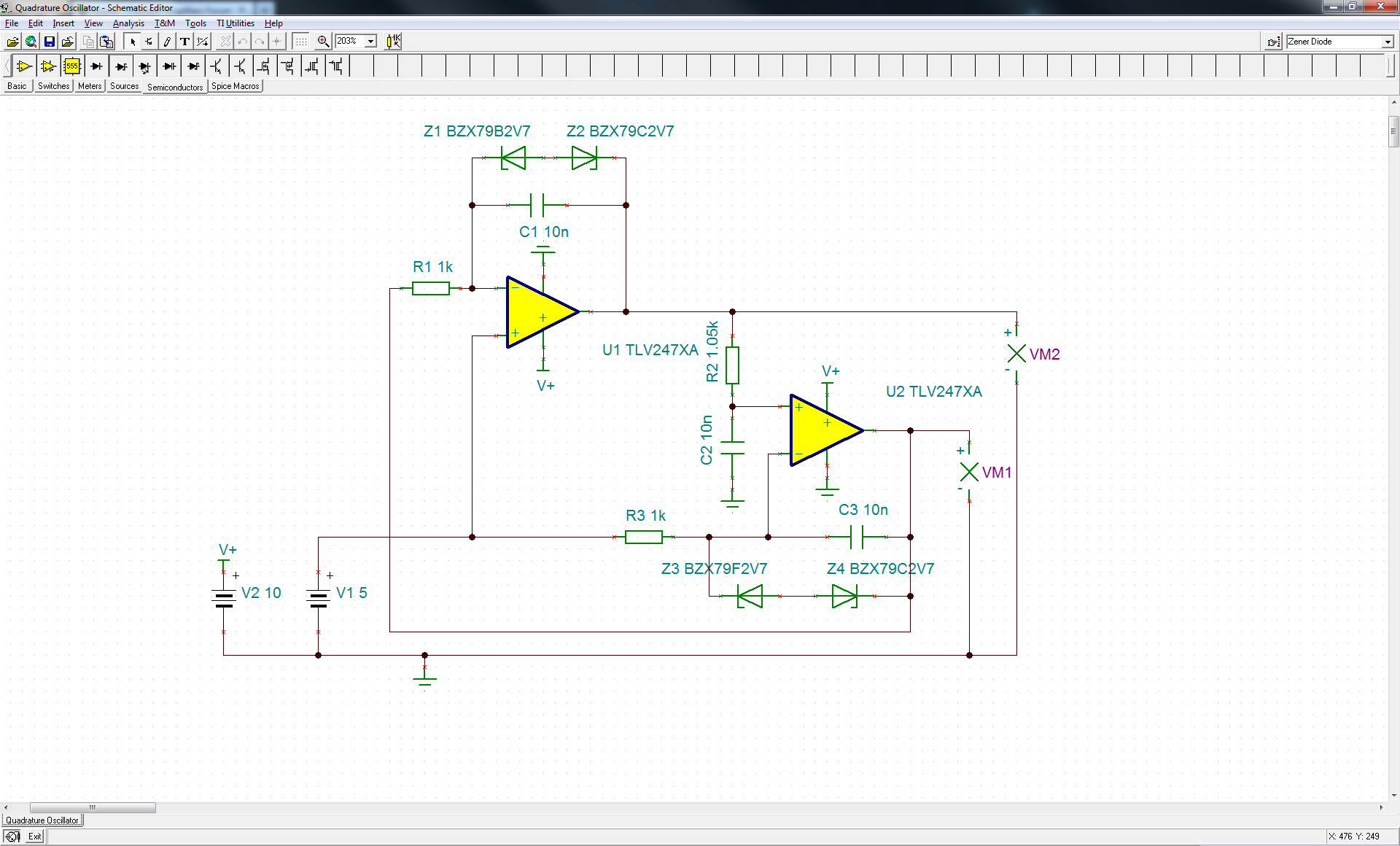
The circuit is close to sustaining oscillation. Changing resistor R2 to 10.5k will enable it to sustain oscillation. The original authors of the referenced note are no longer available for consultation. Oscillators of this type can be complex, as there is a trade-off between providing enough gain to oscillate and avoiding strong distortion. This circuit may require optimization with a nonlinear element to better control feedback for reliable performance. A potential solution could involve using a lamp in a Wien Bridge Oscillator configuration. Adjusting a potentiometer and fine-tuning the circuit might also yield positive results. Recent experimentation included placing two Zener diodes in the feedback loops of both amplifiers. Without the diodes, the output voltages clipped against the supply rails, but with them, the output produced a pure sine/cosine wave. However, this configuration does not function correctly with a 5V supply, likely due to the breakdown voltages of the diodes. This information is shared for those interested in similar projects, and feedback regarding potential pitfalls or redundancies is welcome.
The circuit in question appears to be a Wien Bridge Oscillator, a type of electronic oscillator that generates sine waves. The Wien Bridge Oscillator typically consists of an operational amplifier (op-amp) and a bridge circuit made up of resistors and capacitors that determine the frequency of oscillation. By adjusting the resistance of R2, the gain of the circuit can be modified to achieve the necessary conditions for oscillation.
In the context of this design, the use of Zener diodes in the feedback loop serves to limit the output voltage, preventing clipping and allowing for a cleaner sine wave output. This is crucial in oscillators, as distortion can lead to unreliable performance. The choice of Zener diodes must be compatible with the power supply voltage; in this case, a 5V supply may require diodes with lower breakdown voltages to function correctly.
The introduction of a nonlinear element, such as a lamp or Zener diodes, can stabilize the oscillation by providing automatic gain control. This optimization can help manage the trade-off between gain and distortion, which is a common challenge in oscillator design. A potentiometer can also be incorporated into the circuit to allow for fine-tuning of the oscillation frequency and amplitude.
For practical implementation, careful consideration should be given to the component values and the power supply used. Testing the circuit with real elements will provide valuable insights into its performance and any adjustments that may be necessary. Additionally, documenting any observations during experimentation can be beneficial for future reference or for others attempting similar designs.I did some quick playing with the circuit. It is very close to sustaining oscillation. Changing R2 to 10. 5k will cause it to sustain oscillation. The original authors of the note that you reference are no longer with TI so we cannot consult with them. Oscillators of this type can be tricky and there is a tradeoff between providing enough gain to o scillate and overloading into strong distortion. This circuit would probably require optimization with a nonlinear element to better control the feedback for reliable performance. You mean like the lamp in Hewlett`s Wien Bridge Oscillator I was actually hoping to get around something like this.
Maybe a pot and a little fiddling with the tuning could make it work as well I`ll try to set this up with real elements some time soon and see if it works. Sorry to reopen this thread, but I have been thinking about what you said about non-linear feedback and have placed two Zener diodes in the feedback loops of both amps.
Without the diodes the output voltages run against the rails and clip but with them the output becomes a pure sine/cosine wave. However this does not work for 5 V supply which I assume is due to the breakdown voltages of the diodes.
I am posting this partly to share it with anyone who might want to do something similar in the future and partly to ask if anyone sees any pitfalls or redundancies I overlooked. All content and materials on this site are provided "as is". TI and its respective suppliers and providers of content make no representations about the suitability of these materials for any purpose and disclaim all warranties and conditions with regard to these materials, including but not limited to all implied warranties and conditions of merchantability, fitness for a particular purpose, title and non-infringement of any third party intellectual property right.
TI and its respective suppliers and providers of content make no representations about the suitability of these materials for any purpose and disclaim all warranties and conditions with respect to these materials. No license, either express or implied, by estoppel or otherwise, is granted by TI. Use of the information on this site may require a license from a third party, or a license from TI. Content on this site may contain or be subject to specific guidelines or limitations on use. All postings and use of the content on this site are subject to the Terms of Use of the site; third parties using this content agree to abide by any limitations or guidelines and to comply with the Terms of Use of this site.
TI, its suppliers and providers of content reserve the right to make corrections, deletions, modifications, enhancements, improvements and other changes to the content and materials, its products, programs and services at any time or to move or discontinue any content, products, programs, or services without notice. 🔗 External reference
The circuit in question appears to be a Wien Bridge Oscillator, a type of electronic oscillator that generates sine waves. The Wien Bridge Oscillator typically consists of an operational amplifier (op-amp) and a bridge circuit made up of resistors and capacitors that determine the frequency of oscillation. By adjusting the resistance of R2, the gain of the circuit can be modified to achieve the necessary conditions for oscillation.
In the context of this design, the use of Zener diodes in the feedback loop serves to limit the output voltage, preventing clipping and allowing for a cleaner sine wave output. This is crucial in oscillators, as distortion can lead to unreliable performance. The choice of Zener diodes must be compatible with the power supply voltage; in this case, a 5V supply may require diodes with lower breakdown voltages to function correctly.
The introduction of a nonlinear element, such as a lamp or Zener diodes, can stabilize the oscillation by providing automatic gain control. This optimization can help manage the trade-off between gain and distortion, which is a common challenge in oscillator design. A potentiometer can also be incorporated into the circuit to allow for fine-tuning of the oscillation frequency and amplitude.
For practical implementation, careful consideration should be given to the component values and the power supply used. Testing the circuit with real elements will provide valuable insights into its performance and any adjustments that may be necessary. Additionally, documenting any observations during experimentation can be beneficial for future reference or for others attempting similar designs.I did some quick playing with the circuit. It is very close to sustaining oscillation. Changing R2 to 10. 5k will cause it to sustain oscillation. The original authors of the note that you reference are no longer with TI so we cannot consult with them. Oscillators of this type can be tricky and there is a tradeoff between providing enough gain to o scillate and overloading into strong distortion. This circuit would probably require optimization with a nonlinear element to better control the feedback for reliable performance. You mean like the lamp in Hewlett`s Wien Bridge Oscillator I was actually hoping to get around something like this.
Maybe a pot and a little fiddling with the tuning could make it work as well I`ll try to set this up with real elements some time soon and see if it works. Sorry to reopen this thread, but I have been thinking about what you said about non-linear feedback and have placed two Zener diodes in the feedback loops of both amps.
Without the diodes the output voltages run against the rails and clip but with them the output becomes a pure sine/cosine wave. However this does not work for 5 V supply which I assume is due to the breakdown voltages of the diodes.
I am posting this partly to share it with anyone who might want to do something similar in the future and partly to ask if anyone sees any pitfalls or redundancies I overlooked. All content and materials on this site are provided "as is". TI and its respective suppliers and providers of content make no representations about the suitability of these materials for any purpose and disclaim all warranties and conditions with regard to these materials, including but not limited to all implied warranties and conditions of merchantability, fitness for a particular purpose, title and non-infringement of any third party intellectual property right.
TI and its respective suppliers and providers of content make no representations about the suitability of these materials for any purpose and disclaim all warranties and conditions with respect to these materials. No license, either express or implied, by estoppel or otherwise, is granted by TI. Use of the information on this site may require a license from a third party, or a license from TI. Content on this site may contain or be subject to specific guidelines or limitations on use. All postings and use of the content on this site are subject to the Terms of Use of the site; third parties using this content agree to abide by any limitations or guidelines and to comply with the Terms of Use of this site.
TI, its suppliers and providers of content reserve the right to make corrections, deletions, modifications, enhancements, improvements and other changes to the content and materials, its products, programs and services at any time or to move or discontinue any content, products, programs, or services without notice. 🔗 External reference
Warning: include(partials/cookie-banner.php): Failed to open stream: Permission denied in /var/www/html/nextgr/view-circuit.php on line 713
Warning: include(): Failed opening 'partials/cookie-banner.php' for inclusion (include_path='.:/usr/share/php') in /var/www/html/nextgr/view-circuit.php on line 713
